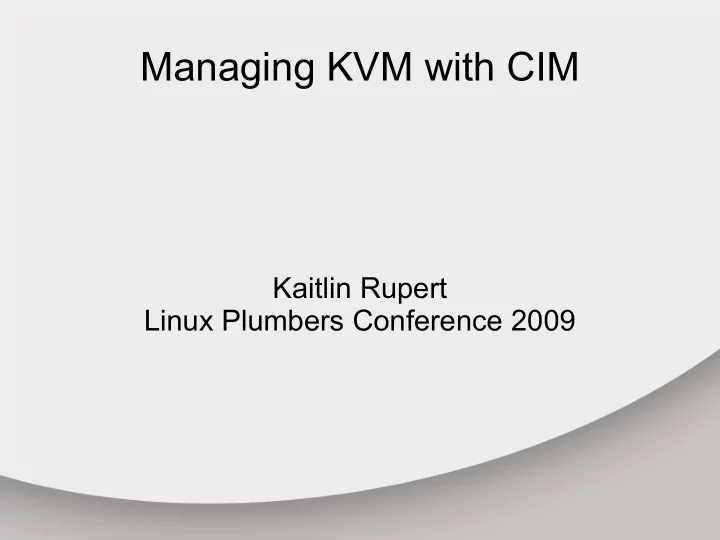

Managing KVM with CIM Kaitlin Rupert Linux Plumbers Conference 2009
Topics ● What is CIM ● CIM glossary ● What CIM provides for virtualization ● Managing KVM with libvirt-cim ● libvirt-cim versus libvirt ● Why CIM? ● Drawbacks of CIM
What is CIM? ● Stands for: Common Information Model ● An open standard defined by the DMTF ● Distributed Management Task Force ● Describes how to control / exchange info about managed elements ● Profiles - model various operations and ways of representing concepts ● Uses a class hierarchy to represent objects and to show inheritance
CIM glossary ● Class – a collection of the definitions of state, behavior, and/or identity of a manageable items in a system ● Contain: – Methods – functions that act on a class – Properties – represent attributes of a manageable item ● Associations – relationship between classes or instances of classes ● Represents: dependency, identity, aggregation, composition
Example of a class diagram
CIM glossary ● Objects – instantiation of a class, usually just called instances ● Provider – a library that represents a given class or classes ● Implements an API for retrieving instances, invoking methods ● CIMOM - Common Information Model Object Manager ● Server that facilitates communication between management application and providers
CMPI ● Common Manageability Programming Interface ● Technical standard developed by the Open Group ● Defines a C-based programming interface ● Prior to CMPI ● Providers had to use CIMOM specific API ● This tied provider sets to a specific CIMOM
What CIM provides for virtualization ● DMTF established for modeling virtualizaiton: ● Server Partitioning, Virtualization, and Clustering (SVPC) workgroup ● Workgroup developed profiles that describe: ● Per guest: – Define / destroy / change power state / migrate – Add / remove / modify virtual resources – Representation of guest and resource configuration data
What CIM provides for virtualization ● Workgroup developed profiles that describe: ● Host wide: – Create / delete / modify resource pools – Representation of pool configuration data – Generate events when a change occurs
Example of the SVPC schema
Managing KVM with libvirt-cim ● A provider set that manages KVM ● Also Xen and Linux Containers ● Uses libvirt for hypervisor abstraction layer ● Providers don't talk directly to hypervisor ● Avoid platform specifics – most code paths are virtualization platform neutral ● Map CIM objects, methods to libvirt abstractions / services where possible
Managing KVM with libvirt-cim CIMOM User Xen_ComputerSystem Management App KVM_ComputerSystem User libvirt-cim virt-manager libvirt Xen QEMU (KVM) LXC
libvirt-cim versus libvirt ● libvirt-cim: ● libvirt ● Parses XML, stores ● Most info is returned data in objects in XML format ● User can listen for ● User must register a event objects using callback and poll a file subscriptions descriptor to get events ● VNC sessions ● Only VNC config info represented represented ● Drawbacks: ● Features lag behind libvirt
Why CIM? ● Allows the management application to control different hypervisor types and even different host types with a single API ● Open standard – all provider sets should work in a known way ● Interoperability between vendors ● Existing open source providers, CIMOMs, and testing tools make for easy development
Drawbacks of CIM ● No mechanism for certifying an implementation conforms to the profiles ● Profiles don't cover all attributes needed ● Can lead to too much specialization in providers ● Reduces interoperability between provider and management app ● Profiles don't exist for all scenarios ● Slow to be published, as they must go through a formal review process ● Developed largely by volunteers
Recommend
More recommend